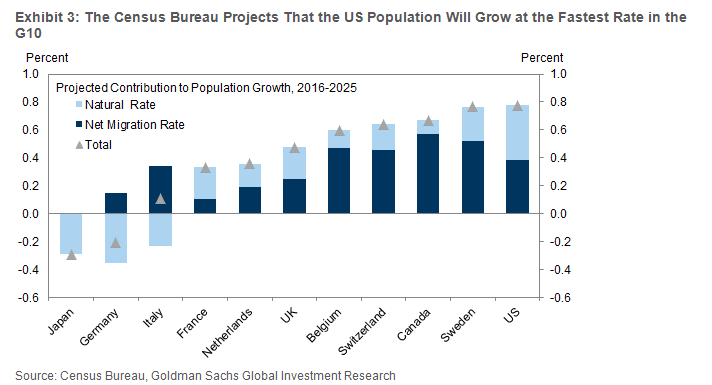The U.S. needs all the immigrants it can get to keep up economic growth — and no, we’re not speaking just about researchers and scientists.

That’s according to Goldman Sachs economists, who, in a recent research note, said U.S. President Donald Trump‘s immigration curbs could cause the U.S. to slide from the top to the middle of the pack among advanced economies in terms of projected population growth.
Here’s where the U.S. would stand with immigration levels left untouched:

The U.S. currently ranks at the top among advanced economies in terms of population growth, something economists have long said bodes well for America’s long-term economic growth. As countries like Japan and Italy flounder under the weight of their aging and shrinking populations, the U.S. has bucked the trend.
But the U.S. could go from outperformer to a middling member of the G10 economies because of the Trump immigration crackdown, Goldman Sachs warned, citing population projections from the U.S. Census Bureau.
In 2014, the Bureau predicted immigrants would account for as much as 60 per cent of the U.S. population growth by 2030.
“Reduced immigration would result in slower labor force growth and therefore slower growth in potential GDP,” Goldman Sachs wrote.
READ MORE: Trump’s new travel ban targets same countries but spares green card holders
Potential GDP is an estimate of how fast an economy can grow without overheating and generating inflation.
- Budget 2024 failed to spark ‘political reboot’ for Liberals, polling suggests
- Train goes up in flames while rolling through London, Ont. Here’s what we know
- Peel police chief met Sri Lankan officer a court says ‘participated’ in torture
- Wrong remains sent to ‘exhausted’ Canadian family after death on Cuba vacation
Goldman Sachs estimates U.S. potential GDP growth at 1.75 per cent, but warned that President Trump’s immigration curbs are “an important source of downside risk” to that.
Potential GDP is tied to the two basic inputs that an economy uses to produce goods and services — labour and capital — and to productivity, which can boost economic output per unit of input.
Because Trump’s immigration caps might sizeably depress the growth rate of the U.S. population, they might also lower the economy’s “speed limit,” argues Goldman Sachs.
READ MORE: Quarter of Canadians support Trump-style ban on Syrian refugees: poll
An even starker picture in Canada
The Census Bureau chart is even starker for Canada, with the blue bar marking population growth due to immigration accounting for almost all the projected increase.
Immigrants were responsible for nearly two-thirds of Canada’s population growth between 2011 and 2016, according to Statistics Canada, with 320,932 new arrivals in 2015-2016 alone, the highest intake for a single year since 1910.
And yet, even that wasn’t enough to avoid a slowdown in population growth from the previous five-year period. Canada added 1.7 million people, or 5 per cent of the population, in the five years leading to 2016, compared to an increased of 5.9 per cent between 2006 and 2011.
The country is on track to see zero population growth in 20 years without immigration, StatsCan predicted.
WATCH: Tory MPs call on Liberals to stop influx of asylum seekers from US

Part of a global “population plateau”?
Canada is hardly alone in this trend. As emerging economies like China face their own demographic cliff, the world’s population as a whole is aging.
The growth rate of the global working age population averaged just under 2 per cent from 1960 to 2005 but has since been slowing down to about 1 per cent, according to Ruchir Sharma, who heads the emerging markets private equity arm of Morgan Stanley.
Sharma and others believe this “population plateau” helps to explain a parallel slowdown in the world economy, which has sputtered along at rates below 3.5 per cent between 2010 and 2015, far below forecasts of 5 per cent average annual growth by the International Monetary Fund.
WATCH: Manitoba RCMP warn refugees of dangerous trek across U.S./Canada border

Such theories have their skeptics. Dire predictions in the eighteenth century that swelling numbers of people would outpace agricultural production and lead to economic catastrophe were disproven when productivity growth outstripped population growth, University of British Columbia economist Kevin Milligan told Global News via email. The link between population growth and economic expansion can be tricky.
Skilled immigrants, of course, can be an important boost to productivity, as well. Goldman Sachs quotes findings from a German study that immigrants account for 25 per cent of U.S. patents, twice their share of America’s population.
Still, regardless of skill, immigrants to the U.S. and Canada tend to be younger than native-born folks, boosting both countries’ working-age populations. And that, too, may help prop up productivity, said Milligan.




Comments